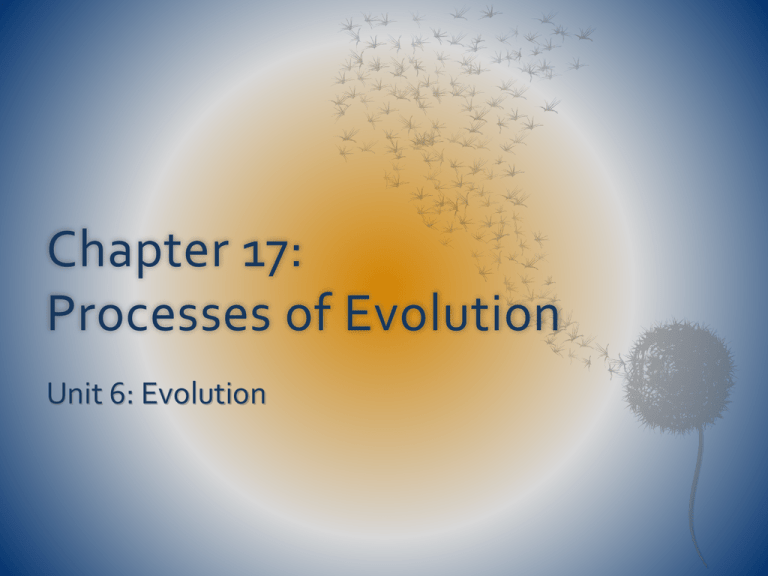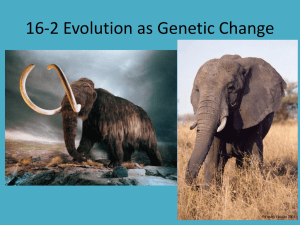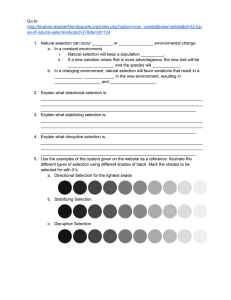Chp 17 student notes part 1
advertisement

Chapter 17: Processes of Evolution Unit 6: Evolution Case Study: Rise of the Super Rats Rats are one of the most notorious pests of all time Cost us about ____________ each year Rodenticide warfarin: very effective when first used Rats developed resistance – inherited gene that made the chemical ineffective This is an example of: __________________________________ Variation in Populations _______________ : one group of individuals of the same species in a specified area Species share: Morphological traits Physiological traits Behavior traits Populations show variation in traits: Qualitative: __________________________ Quantitative: _________________________ The Gene Pool The genes of a population comprise the _______ ________, a pool of genetic resources Alleles are the primary source of variation in appearance Polymorphism: occurs when genes have three or more alleles that persist in a population with a frequency of at least 1% Example: _______________________ ________________ : two distinct traits Example: male / female Mutations Mutations are the source of new alleles We can predict average mutation rates In humans: ________ mutations per person per generation Many mutations give rise to structural, functional, or behavioral alterations that reduce an individual’s chance of surviving and reproducing Mutations Mutations can be: ____________ : usually arise from drastic changes in the phenotype _____________: alter the base sequence of DNA but have no effect on survival or reproduction ______________: enhances the survival or reproduction – occurs every so often Natural selection will favor the transmission of beneficial mutations on to the next generations Stability and Change in Allele Frequencies Researchers typically track _____________ _________________ in populations (how often a certain allele occurs) The relative abundance of alleles of a given gene among all individuals of a population For a starting point, they use a reference called genetic equilibrium, when a population is not evolving with respect to a certain gene Genetic equilibrium can ONLY be reached when five conditions are met Genetic Equilibrium Genetic equilibrium can occur only when: Mutations do not occur The population is infinitely large The population stays isolated from all others of the same species Mating is random All members of the population survive and produce the same number of offspring In nature, _______________________________ Microevolution If all 5 conditions are never met, change is occurring within a population Results in small-scale changes in the population’s allele frequency; called __________________ Four processes of microevolution: mutation natural selection genetic drift gene flow When is a population not evolving? The Hardy-Weinberg Formula can be used to track whether a population is in genetic equilibrium or not A mathematical formula which tracks allele frequency for a specific trait Applied rules of probability to sexually reproducing populations and found that the gene pool can only be stable when __________________________ Researchers can use the formula to estimate the frequency of carriers of alleles that cause genetic traits and disorders Hardy-Weinberg Genetic Equilibrium Hardy-Weinberg formula: p2 + 2 pq + q2 = 1 p+q=1 where p and q are the frequencies of alleles A and a You can draw this on a Punnett square: Natural Selection Natural selection: the differential survival and reproduction among individuals Natural selection influences all levels of biological organization Selection can be: Directional Selection Directional selection occurs when allele frequencies shift in a _____________________ Forms at one end of the range of phenotypic variations become more common than the intermediate forms Examples: Peppered Moth, pocket mice (predation) Resistance to antibiotics Directional Selection Butterfly wing color: medium-blue is between two phenotypic extremes (white and dark purple) Orange arrows identify which forms are being selected against over time Figure 17.5, page 270 Peppered Moth Peppered moth: a classic example of the directional selection process Feed at night and rest on tree trunks during day Light gray lichens grew on trees In preindustrial England, light colored moths were the most common Due to air pollution starting in 1850s, the dominant allele shifted to dark colored moths Air pollution was _________________________ Peppered Moth Figure 17.6, pg 271 Since the advent of pollution controls starting in 1950s, allele frequency has begun to shift back to light colored moths Pocket Mice Figure 17.7, pg 271 Rock pocket mice in Arizona are another example of directional selection Light brown granite; dark basalt (lava rock) Resistance to Antibiotics Human activity can also influence directional selection Antibiotics: toxins that kill bacteria by interfering in physiological processes Since 1940s, have been widely prescribed in the U.S. Overuse of antibiotics puts tremendous selection pressure on bacteria Bacteria divide quickly and form huge populations with great genetic variation E. coli can divide every _________________ Likely that some will survive antibiotic treatment Resistant strains are becoming the norm Selection Against or in Favor of Extreme Phenotypes Stabilizing Selection: works against phenotypes at the fringes of a range Disruptive Selection: favors phenotypes at the fringes of a range Stabilizing Selection Stabilizing selection: intermediate forms of a trait in a population are favored Does NOT _______________________________ Examples: Birth weight for babies – mid-sized babies selected for most often Body mass size of sociable weaver birds Body mass represents a trade-off between risks of starvation and predation Stabilizing Selection Stabilizing eliminates the ______________ Figure 17.8a, pg 272 Disruptive Selection Disruptive selection: forms at both ends of a range of variation are favored Intermediate forms are ______________________ Example: selection for bill size in black-bellied seedcracker finch in Africa Females and males have either large or small bills (no intermediate ones) 2 different types of plants: hard or soft seeds Feeding performance maintains this dimorphism of beak size Disruptive Selection Disruptive selection eliminates _______________________ Figure 17.8b, pg 272 Modes of Natural Selection Fig 17.4, page 269







